6.22: Energy Flow
- Page ID
- 1491
\( \newcommand{\vecs}[1]{\overset { \scriptstyle \rightharpoonup} {\mathbf{#1}} } \)
\( \newcommand{\vecd}[1]{\overset{-\!-\!\rightharpoonup}{\vphantom{a}\smash {#1}}} \)
\( \newcommand{\dsum}{\displaystyle\sum\limits} \)
\( \newcommand{\dint}{\displaystyle\int\limits} \)
\( \newcommand{\dlim}{\displaystyle\lim\limits} \)
\( \newcommand{\id}{\mathrm{id}}\) \( \newcommand{\Span}{\mathrm{span}}\)
( \newcommand{\kernel}{\mathrm{null}\,}\) \( \newcommand{\range}{\mathrm{range}\,}\)
\( \newcommand{\RealPart}{\mathrm{Re}}\) \( \newcommand{\ImaginaryPart}{\mathrm{Im}}\)
\( \newcommand{\Argument}{\mathrm{Arg}}\) \( \newcommand{\norm}[1]{\| #1 \|}\)
\( \newcommand{\inner}[2]{\langle #1, #2 \rangle}\)
\( \newcommand{\Span}{\mathrm{span}}\)
\( \newcommand{\id}{\mathrm{id}}\)
\( \newcommand{\Span}{\mathrm{span}}\)
\( \newcommand{\kernel}{\mathrm{null}\,}\)
\( \newcommand{\range}{\mathrm{range}\,}\)
\( \newcommand{\RealPart}{\mathrm{Re}}\)
\( \newcommand{\ImaginaryPart}{\mathrm{Im}}\)
\( \newcommand{\Argument}{\mathrm{Arg}}\)
\( \newcommand{\norm}[1]{\| #1 \|}\)
\( \newcommand{\inner}[2]{\langle #1, #2 \rangle}\)
\( \newcommand{\Span}{\mathrm{span}}\) \( \newcommand{\AA}{\unicode[.8,0]{x212B}}\)
\( \newcommand{\vectorA}[1]{\vec{#1}} % arrow\)
\( \newcommand{\vectorAt}[1]{\vec{\text{#1}}} % arrow\)
\( \newcommand{\vectorB}[1]{\overset { \scriptstyle \rightharpoonup} {\mathbf{#1}} } \)
\( \newcommand{\vectorC}[1]{\textbf{#1}} \)
\( \newcommand{\vectorD}[1]{\overrightarrow{#1}} \)
\( \newcommand{\vectorDt}[1]{\overrightarrow{\text{#1}}} \)
\( \newcommand{\vectE}[1]{\overset{-\!-\!\rightharpoonup}{\vphantom{a}\smash{\mathbf {#1}}}} \)
\( \newcommand{\vecs}[1]{\overset { \scriptstyle \rightharpoonup} {\mathbf{#1}} } \)
\( \newcommand{\vecd}[1]{\overset{-\!-\!\rightharpoonup}{\vphantom{a}\smash {#1}}} \)
\(\newcommand{\avec}{\mathbf a}\) \(\newcommand{\bvec}{\mathbf b}\) \(\newcommand{\cvec}{\mathbf c}\) \(\newcommand{\dvec}{\mathbf d}\) \(\newcommand{\dtil}{\widetilde{\mathbf d}}\) \(\newcommand{\evec}{\mathbf e}\) \(\newcommand{\fvec}{\mathbf f}\) \(\newcommand{\nvec}{\mathbf n}\) \(\newcommand{\pvec}{\mathbf p}\) \(\newcommand{\qvec}{\mathbf q}\) \(\newcommand{\svec}{\mathbf s}\) \(\newcommand{\tvec}{\mathbf t}\) \(\newcommand{\uvec}{\mathbf u}\) \(\newcommand{\vvec}{\mathbf v}\) \(\newcommand{\wvec}{\mathbf w}\) \(\newcommand{\xvec}{\mathbf x}\) \(\newcommand{\yvec}{\mathbf y}\) \(\newcommand{\zvec}{\mathbf z}\) \(\newcommand{\rvec}{\mathbf r}\) \(\newcommand{\mvec}{\mathbf m}\) \(\newcommand{\zerovec}{\mathbf 0}\) \(\newcommand{\onevec}{\mathbf 1}\) \(\newcommand{\real}{\mathbb R}\) \(\newcommand{\twovec}[2]{\left[\begin{array}{r}#1 \\ #2 \end{array}\right]}\) \(\newcommand{\ctwovec}[2]{\left[\begin{array}{c}#1 \\ #2 \end{array}\right]}\) \(\newcommand{\threevec}[3]{\left[\begin{array}{r}#1 \\ #2 \\ #3 \end{array}\right]}\) \(\newcommand{\cthreevec}[3]{\left[\begin{array}{c}#1 \\ #2 \\ #3 \end{array}\right]}\) \(\newcommand{\fourvec}[4]{\left[\begin{array}{r}#1 \\ #2 \\ #3 \\ #4 \end{array}\right]}\) \(\newcommand{\cfourvec}[4]{\left[\begin{array}{c}#1 \\ #2 \\ #3 \\ #4 \end{array}\right]}\) \(\newcommand{\fivevec}[5]{\left[\begin{array}{r}#1 \\ #2 \\ #3 \\ #4 \\ #5 \\ \end{array}\right]}\) \(\newcommand{\cfivevec}[5]{\left[\begin{array}{c}#1 \\ #2 \\ #3 \\ #4 \\ #5 \\ \end{array}\right]}\) \(\newcommand{\mattwo}[4]{\left[\begin{array}{rr}#1 \amp #2 \\ #3 \amp #4 \\ \end{array}\right]}\) \(\newcommand{\laspan}[1]{\text{Span}\{#1\}}\) \(\newcommand{\bcal}{\cal B}\) \(\newcommand{\ccal}{\cal C}\) \(\newcommand{\scal}{\cal S}\) \(\newcommand{\wcal}{\cal W}\) \(\newcommand{\ecal}{\cal E}\) \(\newcommand{\coords}[2]{\left\{#1\right\}_{#2}}\) \(\newcommand{\gray}[1]{\color{gray}{#1}}\) \(\newcommand{\lgray}[1]{\color{lightgray}{#1}}\) \(\newcommand{\rank}{\operatorname{rank}}\) \(\newcommand{\row}{\text{Row}}\) \(\newcommand{\col}{\text{Col}}\) \(\renewcommand{\row}{\text{Row}}\) \(\newcommand{\nul}{\text{Nul}}\) \(\newcommand{\var}{\text{Var}}\) \(\newcommand{\corr}{\text{corr}}\) \(\newcommand{\len}[1]{\left|#1\right|}\) \(\newcommand{\bbar}{\overline{\bvec}}\) \(\newcommand{\bhat}{\widehat{\bvec}}\) \(\newcommand{\bperp}{\bvec^\perp}\) \(\newcommand{\xhat}{\widehat{\xvec}}\) \(\newcommand{\vhat}{\widehat{\vvec}}\) \(\newcommand{\uhat}{\widehat{\uvec}}\) \(\newcommand{\what}{\widehat{\wvec}}\) \(\newcommand{\Sighat}{\widehat{\Sigma}}\) \(\newcommand{\lt}{<}\) \(\newcommand{\gt}{>}\) \(\newcommand{\amp}{&}\) \(\definecolor{fillinmathshade}{gray}{0.9}\)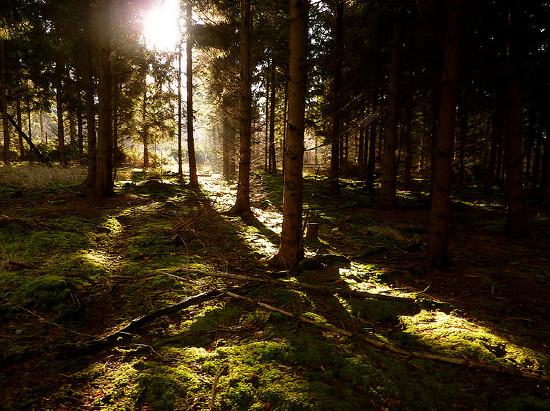
What is happening inside each leaf and blade of grass?
Photosynthesis. Maybe the most important biochemical reaction of Earth. As sunlight shines down on this forest, the sunlight is being absorbed, and the energy from that sunlight is being transformed into chemical energy. That chemical energy is then distributed to all other living organisms in the ecosystem.
Flow of Energy
To survive, ecosystems need a constant influx of energy. Energy enters ecosystems in the form of sunlight or chemical compounds. Some organisms use this energy to make food. Other organisms get energy by eating the food.
Producers
Producers are organisms that produce food for themselves and other organisms. They use energy and simple inorganic molecules to make organic compounds. The stability of producers is vital to ecosystems because all organisms need organic molecules. Producers are also called autotrophs. There are two basic types of autotrophs: photoautotrophs and chemoautotrophs.
- Photoautotrophs use energy from sunlight to make food by photosynthesis. They include plants, algae, and certain bacteria (see Figure below).
- Chemoautotrophs use energy from chemical compounds to make food by chemosynthesis. They include some bacteria and also archaea. Archaea are microorganisms that resemble bacteria.
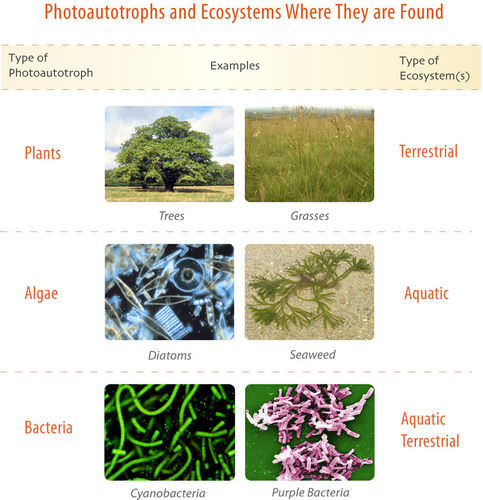 Different types of photoautotrophs are important in different ecosystems.
Different types of photoautotrophs are important in different ecosystems.Consumers
Consumers are organisms that depend on other organisms for food. They take in organic molecules by essentially “eating” other living things. They include all animals and fungi. (Fungi don't really “eat”; they absorb nutrients from other organisms.) They also include many bacteria and even a few plants, such as the pitcher plant shown in Figure below. Consumers are also called heterotrophs. Heterotrophs are classified by what they eat:
- Herbivores consume producers such as plants or algae. They are a necessary link between producers and other consumers. Examples include deer, rabbits, and mice.
- Carnivores consume animals. Examples include lions, polar bears, hawks, frogs, salmon, and spiders. Carnivores that are unable to digest plants and must eat only animals are called obligate carnivores. Other carnivores can digest plants but do not commonly eat them.
- Omnivores consume both plants and animals. They include humans, pigs, brown bears, gulls, crows, and some species of fish.
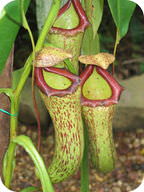 Pitcher Plant. Virtually all plants are producers. This pitcher plant is an exception. It consumes insects. It traps them in a sticky substance in its “pitcher.” Then it secretes enzymes that break down the insects and release nutrients. Which type of consumer is a pitcher plant?
Pitcher Plant. Virtually all plants are producers. This pitcher plant is an exception. It consumes insects. It traps them in a sticky substance in its “pitcher.” Then it secretes enzymes that break down the insects and release nutrients. Which type of consumer is a pitcher plant?Decomposers
When organisms die, they leave behind energy and matter in their remains. Decomposers break down the remains and other wastes and release simple inorganic molecules back to the environment. Producers can then use the molecules to make new organic compounds. The stability of decomposers is essential to every ecosystem. Decomposers are classified by the type of organic matter they break down:
- Scavengers consume the soft tissues of dead animals. Examples of scavengers include vultures, raccoons, and blowflies.
- Detritivores consume detritus—the dead leaves, animal feces, and other organic debris that collects on the soil or at the bottom of a body of water. On land, detritivores include earthworms, millipedes, and dung beetles (see Figure below). In water, detritivores include “bottom feeders” such as sea cucumbers and catfish.
- Saprotrophs are the final step in decomposition. They feed on any remaining organic matter that is left after other decomposers do their work. Saprotrophs include fungi, bacteria and single-celled protozoa. Fungi are the only organisms that can decompose wood.
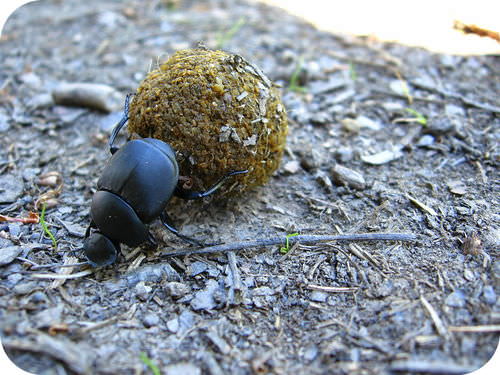 Dung Beetle. This dung beetle is rolling a ball of feces to its nest to feed its young.
Dung Beetle. This dung beetle is rolling a ball of feces to its nest to feed its young.KQED: Banana Slugs: The Ultimate Recyclers
One of the most beloved and iconic native species within the old growth redwood forests of California is the Pacific Banana Slug. These slimy friends of the forest are the ultimate recyclers. Feeding on fallen leaves, mushrooms or even dead animals, they play a pivotal role in replenishing the soil. QUEST goes to Henry Cowell Redwoods State Park near Santa Cruz, California on a hunt to find Ariolimax dolichophallus, a bright yellow slug with a very big personality.
Summary
- Ecosystems require constant inputs of energy from sunlight or chemicals.
- Producers use energy and inorganic molecules to make food.
- Consumers take in food by eating producers or other living things.
- Decomposers break down dead organisms and other organic wastes and release inorganic molecules back to the environment.
Review
- Identify three different types of consumers. Name an example of each type.
- What are photoautotrophs? Give an example of one.
- What can you infer about an ecosystem that depends on chemoautotrophs for food?
- What is the role of decomposers?
- What do scavengers do? Give an example of a scavenger.
| Image | Reference | Attributions |
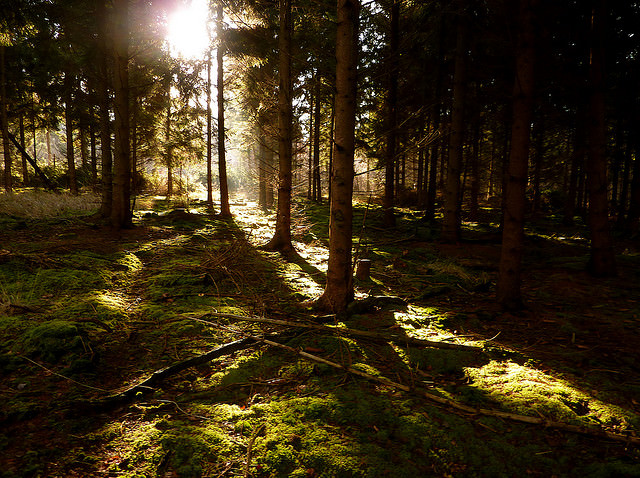 |
[Figure 1] | Credit: Amy Goldstein Source: http://www.flickr.com/photos/amylovesyah/3945525048/ License: CC BY 2.0 |
 |
[Figure 2] | Credit: Tree: User:Haabet/Wikimedia Commons; Grass: User:Polishname/Wikipedia; Diatoms: Gordon T. Taylor/Stony Brook University/NOAA; Seaweed: User:Flyingdream/Wikipedia; Cyanobacteria: Barry H. Rosen/USGS; Purple bacteria: Janice Carr/CDC Source: Tree: commons.wikimedia.org/wiki/File:Raunkiaer.jpg ; Grass: commons.wikimedia.org/wiki/File:TallWildGrass.jpg ; Diatoms: commons.wikimedia.org/wiki/File:Diatoms_through_the_microscope.jpg ; Seaweed: commons.wikimedia.org/wiki/File:Codiumfragile.jpg ; Cyanobacteria: http://microbiology.usgs.gov/image_gallery_cyanobacteria_phormidium.html ; Purple bacteria: (ID 9999)phil.cdc.gov/phil/details.asp License: Public Domain |
 |
[Figure 3] | Credit: Tim Mansfield Source: http://www.flickr.com/photos/timbomb/406235908/ License: CC BY 2.0 |
 |
[Figure 4] | Credit: Amy Goldstein Source: http://www.flickr.com/photos/amylovesyah/3945525048/ License: CC BY 2.0 |

